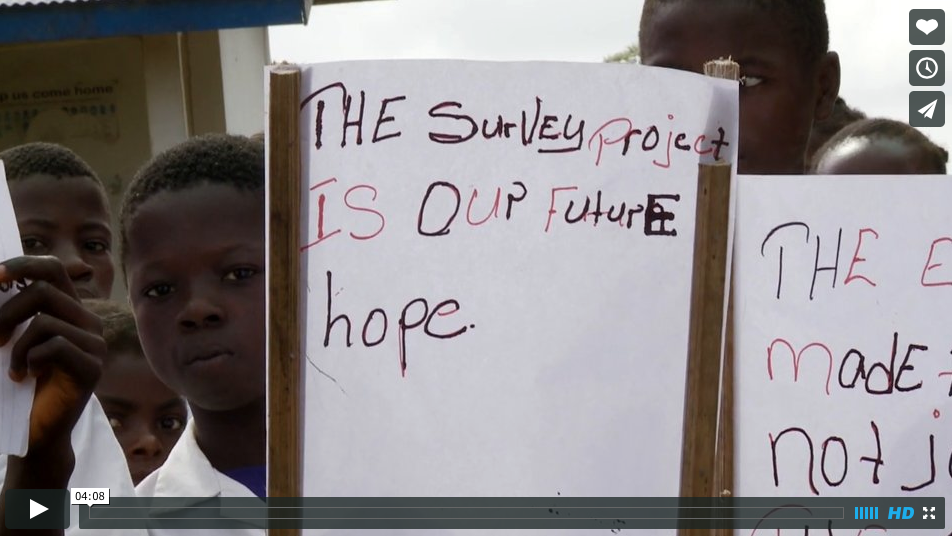
The work of Namati’s Liberian partner, the Sustainable Development Institute, has been captured on film by the climate change campaign organisation If Not Us Then Who. Made by Handcrafted Films for their Inspirational People strand, the short film shows the community mapping that rural people use to begin the process of protecting their lands.
In a country where over half of the land has been promised to or contracted to investors, leaving many rural Liberians landless and livelihood insecure, Namati and SDI are currently working with 65 communities to realize their rights and protect their customary land and natural resources.
Inspirational People – Silas and community mapping from Handcrafted Films on Vimeo.
To accompany the film SDI’s Ali Kaba and Namati’s Chelsea Keyser have written a blog post that originally appeared on the If Not Us Then Who website.
By Ali D. Kaba and Chelsea Keyser
The Government of Liberia has a long history of granting large tracks of land to foreign investors at the expense of the livelihoods of rural populations. As early as 1926, when other Sub-Sahara Africa countries were agitating for political freedom, the Liberian government signed a concession agreement with Firestone, an American owned rubber company, that transferred 1 million acres of the country’s land.This concession agreement left the customary owners of the land “squatters” or landless, and set a precedent for exploitative concession agreements in the years to come.
Fueled on the neo-liberal ideology for economic growth through private investment, a series of land based concessions for mining, forestry, and agricultural plantation were issued. By the late 1950s, as much as 15% of the country’s land had been placed under some form of contract agreement with foreign investors. And by 2010s, in a rush to “develop the country’s post-war infrastructure and institutions”, over half of the country’s land had been promised to or contracted to investors, leaving many rural Liberians landless and livelihood insecure. Although Liberia is rich in natural resources, the profits derived from the concession have not translated into equitable development for average Liberians. Liberia ranks 175 out of 187 on the Human Development Index, 2/3 of the population lives on under $1.25 per day,, 60% of all food is imported, and the country suffers from an unemployment rate of 85%.
However, over the past 8 years the Sustainable Development Institute (SDI) and other Liberian civil society organizations have advocated for the strengthening of community’s rights over land and natural resources and a more transparent inclusive land allocation process. Their calls for reform have not gone unheard. The 2006 National Forest Reform Law, the 2009Community Rights Law, and the 2013 Land Rights Policy recognized for the first time in the country’s history, community’s rights over forest resources and customary land.. While these reform as written indicate a radical departure from the past, the journey from policy to practice has been slow and fraught with challenges from lack of political will to insufficient capacity to implement the law.
In this context, strong and expedient implementation of the legal framework that safeguards community’s rights to lands and natural resources is urgently necessary. SDI’s Community Land Protection Program (CLPP) and its partner, NAMATI, have been working with communities in Rivercess County since 2009 to test an efficient framework for community land tilting.
SDI and NAMATI’s approach relies on working with local structure, building on local knowledge and encouraging collective community participation to provide a mutually beneficial community land documentation process. The simple, low cost approach requires intensive field work to help communities establish local governance structure, draft community rules, agree on common boundaries with neighbors, and build their capacity to sustainably and equitably manage their land and resources. SDI is currently working with 65 communities in Liberia to realize their rights and protect their customary land and natural resources.
Supporting rural communities in Liberiato leverage these national laws to document their lands and protect their land and natural resources, also has the potential to foster remarkable changes: communities wrote down their customary rules for the first time in living memory, and then revised them to protect women’s rights, hold local leaders accountable, and align community norms and practices with national law. Moreover, the process led communities to resolve long-standing boundary disputes that had fueled local conflict for decades. Such outcomes are particularly critical in post-conflict regions riddled by years of violence, strife and corruption.
This is the direction that Liberia must continue to take to redefine its future. Liberia, Africa’s oldest republic, can become the model for developing innovative tools, approaches and practices to recognize and protect the land rights of its citizens, especially those in the rural areas. But, realizing the land rights of rural Liberians will require the continued support and investment of all stakeholders, the Liberian government, civil society, rural communities, private investors and the international community.